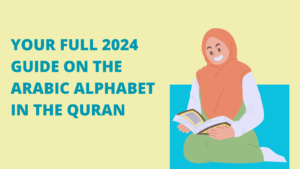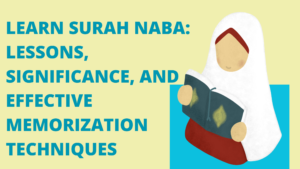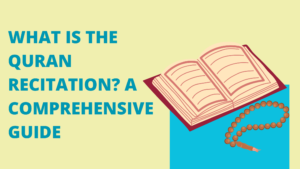In this blog post, we aim to explore the world of Hamzah and dive into the concept of Hamzat al-Wasl in great detail. We will provide a comprehensive definition, outline the rules associated with it, present examples found in the Quran, and emphasize the key distinctions between Hamzat al-Wasl and Hamzat al-Qat.
Prepare yourself for this linguistic adventure as we work together to improve our understanding of this fascinating aspect of Arabic grammar!
Table of Contents
What is Hamzah?
Hamzah is the Arabic letter that represents a glottal stop sound, similar to the “A” sound in English. It is represented by the symbol (ء) and can appear above or below certain letters in writing.
In words, Hamzah is used to indicate the presence of a glottal stop at the beginning of a word, before a vowel or consonant.
It is important to note that Hamzah is not a separate letter but rather a diacritic that modifies the pronunciation of the letter it accompanies. Its usage is essential for correct pronunciation and understanding of the Arabic language.
Learn more about the correct pronunciation of Arabic letters with Tajweed. Improve your recitation and understanding of the Quran by mastering proper letter sounds and pronunciation techniques.
Types of Hamza in Arabic
In the Arabic language, there are two types of Hamza: Hamzat al-Qat and Hamzat al-Wasl. These two variations play a significant role in pronunciation and grammar.
1. Hamzat al-Wasl:
This type of Hamza acts as a connecting Hamza and is only pronounced at the beginning of a word. It assimilates or joins with the following letter if it occurs within a word, such as in “اتل” (read as “iltu”).
2. Hamzat al-Qat:
This type of Hamza is a non-connecting Hamza and is indicated by a small letter hamza (ء) placed above the word’s first letter.
It is used to pronounce a glottal stop when a word begins with a letter that has Sukoon or hamza, such as in “أجل” (read as “ajal”). Hamzat al-Qat interrupts stops, or ends the utterance, unlike Hamzat al-Wasl.
What is Hamzat al-Wasl?
Hamzat al-Wasl, also known as Aliful-wasl or the Connecting Hamza, is a glottal stop sound that occurs at the beginning of certain words in the Arabic language.
It is pronounced as a typical vowel sound and appears in the form of a small superscript sign, called Hamza (ٱ), above the letter Alif in the Quran.
In written Arabic, the Hamza symbol is not always explicitly written but is indicated by a diacritic symbol above the preceding vowel.
Hamzat al-Wasl serves to connect the word to the preceding word in speech and recitation but does not end the sentence or break it. Its correct usage is important for accurate pronunciation, grammar, and the proper recitation of the Quran.
Pronunciation of Hamzat al-Wasl
The correct pronunciation of Hamzat al-Wasl is crucial for understanding the Arabic language. It can be categorized as follows:
1. When Hamzat al-Wasl is followed by the definite article ال, the Hamza should be assigned a Fatha on top of it (e.g., النار).
2. If Hamzat al-Wasl occurs at the beginning of specific nouns or pronouns such as (ابن, اثنتين, امرأة, اسم) it is pronounced by assigning a Kasrah underneath it.
3. If the above cases do not apply, the pronunciation of the Hamza depends on the third letter of the word starting with Hamzat al-Wasl:
– If the third letter has a Fatha or Kasrah, pronounce the Hamza with Kasrah (e.g., انقَلبوا).
– If the third letter has a Dummah, assign a Dummah to the Hamza as well (e.g., اسجُد).
4. There are exceptions to this last point in certain words, such as ابنوا, امشوا, اقضوا, ائتوا, ائتوني, where the pronunciation of the Hamza differs.
Rules for Hamzat al-Wasl
When discussing Hamzat al-Wasl, it is important to follow specific rules to pronounce it accurately. These rules aid in proper enunciation and improve the overall fluidity of speech. Here are some essential guidelines for Hamzat al-Wasl:
1. Occurrence at the Beginning of the Word:
Hamzat al-Wasl in Tajweed is an extra hamza at the beginning of the word. It is found in verbs, nouns, and letters. This rule applies because the Arabs do not typically begin words with a consonant sound.
2. Fixed Position and Omission:
Hamzat al-Wasl is fixed at the beginning of the word and is omitted if a vowel letter precedes or when connecting the word to the one before it.
This is because the consonant letter after Hamzat al-Wasl is dependent on the spoken letter that preceded it. For example: الْبَيْتُ (al-baytu).
3. Presentation in Writing and Pronunciation:
In Tajweed, Hamzat al-Wasl is written in a manner like the letter alif (ا). However, in the Holy Qur’an, it is marked with a little saad (صــ) above the Alif (ٱ). This notation helps differentiate it from the regular letter alif.
When the reciter starts with a term that contains Hamzat al-Wasl, it is audibly sounded. This means that Hamzat al-Wasl is pronounced when starting with the word. For example: ٱلَّذِينَ (alladhīna).
4. Definite Article (Hazmat-Tarif):
The definite article “ال” (al) is considered a Hamzat al-Wasl and is not written, even though it is pronounced clearly as if it is a regular Hamzat al-Qat.
This rule applies specifically to the definite article in Arabic, and it helps maintain the proper pronunciation and flow of the language. For example: الرَّجُلُ (ar-rajulu).
Examples of Hamzat al-Wasl in the Quran
The Quran, being the holy book of Islam, contains numerous examples of Hamzat al-Wasl. Here are some instances where this type of hamza is found:
Example 1:
In the phrase “وَأَمَّا مَن بَخِلَ وَاسْتَغْنَى” (wa amma man bakhila wastaghna), Hamzat al-Wasl is present in the word “استَغْنَى” (istaghna), which means “he became self-sufficient” in this context.
The alif at the beginning of the word is not written with a hamza because it is preceded by the conjunction “wa”. The hamza is silent and cannot be pronounced.
Example 2:
In the phrase “فَادْخُلِي فِي عِبَادِي” (fadkhuli fi ibadi), Hamzat al-Wasl is present in the word “فَادْخُلِي” (fadkhuli), which means “enter” (addressed to Maryam/Mary).
The alif at the beginning of the word is not written with a hamza because it is preceded by the conjunction “fa”. The hamza is silent and cannot be pronounced.
Start your child’s journey of learning the Quran with proper pronunciation and recitation by enrolling them in our online Tajweed Quran classes at Bayan Al-Quran.
Difference Between Hamzat al-Wasl and Hamzat al-Qat
Hamzat al-Wasl is a connecting hamza that occurs at the beginning of a word and is silent when it appears in the middle of a sentence. Hamzat al-Qat, on the other hand, can appear at any position in a word and is pronounced accordingly. Here are some key differences between them:
1. Position:
Hamzat al-Wasl is only heard at the beginning of a word or phrase, while Hamzat al-Qat can occur at the beginning, middle, or end.
2. Diacritical mark:
Hamzat al-Wasl does not appear with a diacritical mark, while Hamzat al-Qat can have a diacritical mark or sukon.
3. Form:
Hamzat al-Wasl is always represented by the plain Alif without a hamza, while Hamzat al-Qat can take different forms.
4. Pronunciation:
Hamzat al-Wasl is silent or ignored when it appears in the middle of a sentence or verse, while Hamzat al-Qat must be pronounced.
5. Distinguishing factor:
Adding a conjunction, such as the letter waw (و), before the word can help distinguish between Hamzat al-Wasl and Hamzat al-Qat based on the pronunciation of the hamzah.
Join us today at Bayan Al-Quran Academy for an enriching educational journey that will inspire your child’s spiritual growth!
Bayan Al-Quran Academy offers engaging and comprehensive online Arabic courses for kids specially designed for children. With our innovative teaching techniques and e-learning resources, children can learn Arabic in a fun and interactive way.
Our experienced Arabic Egyptian tutors, who are native speakers, ensure that kids grasp the language effectively. From learning the basics of the Arabic alphabet to developing fluency in speaking and reading, our courses cover all aspects of Arabic language learning.
Give your child the gift of language and cultural understanding with our online Arabic courses for kids at Bayan Al-Quran Academy.
Conclusion
Hamzat al-Wasl and Hamzat al-Qat are two types of the Arabic letter “Hamza” with distinct characteristics. Hamzat al-Wasl occurs at the beginning of a word and connects it to the previous word, while Hamzat al-Qat appears in the middle or end of a word.
The pronunciation and rules for Hamzat al-Wasl differ from other forms of Hamza. It is important to understand these rules to correctly pronounce words and recite verses from the Quran. Examples from the Quran demonstrate how this concept is applied in practice.
Knowing the differences between Hamzat al-Wasl and Hamzat al-Qat will enhance your understanding of Arabic grammar and contribute to your proficiency in reading and reciting religious texts.
Bayan Al-Quran Academy offers courses in Arabic language and Quranic studies to help you deepen your understanding and improve your recitation.


















